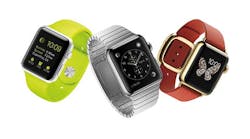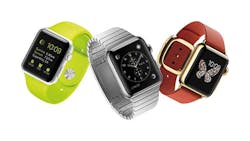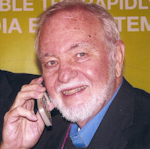Are you feeling naked yet without your electronic wearables? Wearables is one of the most controversial new consumer electronic product categories to emerge in a long time. Yet, the idea of packaging electronic products to wear on your body is not new. Now there is renewed interest in getting you to buy an electronic gadget you can wear. Like a lot of products, you don’t necessarily need them; you just may want to look trendy.
Electronic wrist watches were probably the first electronic wearables. The early crystal and tuning fork watches are an example. Following these were the digital watches of the 1970s, first with LEDs then later with LCDs.
Another popular wearable was the famous Sony Walkman that attached to your belt. One of the hottest products ever. Then there were the pagers. Remember those? Lots of people carried one on their belts in the 1990s until cell phones really took off. Cell phones were another belt attachment and still are. Oh yes, let’s not forget hearing aids. These are better than ever with DSP and longer life batteries.
Of course there are lots of other electronic items that people wear. Radios are an example. AM/FM radios with headphones were popular with runners. Now it is iPods or some other MP3 music player. Policemen carry all sorts of wearables like radios, flashlights, and today even personal video cams. The same for soldiers who carry radios, video cams, night vision goggles, laser sights, and other stuff we are not supposed to know about.
The latest wearables trend is fitness accessories. Heart rate monitors, pedometers, temperature and other sensors are examples. Watch bands are the most popular and so are headbands, chest bands, arm bands and even smart bras and shirts. These devices collect and record all sorts of performance and fitness data.
Glasses are a long time wearable but now there is Google Glass. Even Sony has a similar product called SmartEyeglass. Both are still in the testing stages with possible future sales. These devices are still a bit wonky and invasive so make people uncomfortable. Maybe they will find a niche, or not. Forget those geeky virtual reality goggles, for now.
Probably the wearable with the most potential is still the wrist watch. It has been around for decades and is still popular. Many consider the watch as a status symbol like the Rolex, Breitling, Patek Philippe, TAG Heuer and the likes. The affluent still pay thousands even tens of thousands for a status watch. You know, the ones with all those tiny hard to read and never used little dials or the fashion watches with no dials. Yet, many have given up watches in favor of their smartphone. I wore a watch all my life up until a few years ago when I started carrying the iPhone. Although I admit that I still glance at my wrist occasionally hoping to get a fast glimpse of the time. Now I have to take the iPhone out of my pocket first. How inconvenient. Maybe it is time for a resurgence of the wrist watch.
My favorite watch was not the glow in the dark Timex I wore for years but the Casio digital with the calculator. I used it for years working through three new bands and three batteries. I really used the calculator while I was still teaching and the stop watch for my runs. I still have it but it has a broken band, again. Another favorite watch is my “atomic” watch. It has a built in radio to receive the National Institute of Standards and Technology’s (NISTs) WWVB time station on 60 kHz in Colorado. It broadcasts digital time ticks linked to an atomic clock so keeps the watch dead-on accurate at all times. Totally cool. Or am I just a geek?
Today we have the smartwatch. The fitness watches were the first smartwatches from Pebble, Garmin, Fitbit, Polar and others. Both Samsung and Sony have smartwatches. So does Motorola. All are tethered to a companion smartphone. While they all tell time, these watches are peripherals to the phone via Bluetooth. A real standout, in my mind, is TIMEX’s new IRONMAN ONE GPS+. It does not need a smartwatch base as it has its own cellular connectivity with the AT&T network. Its GPS feature allows others to locate the wearer and it has a wealth of fitness features for keeping track of time and distance.
The new Apple Watch has renewed interest in the smartwatch movement. Maybe it will stimulate this still nascent marketplace. This new watch also tells time and provides email and text alerts like all the others but it has some benefits. Apple and third party vendors will provide apps keyed to the Watch. The Watch also has built in NFC (near field communications) like the new iPhone 6s so you can pay for purchases using the new Apple Pay system. No need to use a credit card when you can just tap the phone or Watch to the POS terminal. The key I believe is making the watch more useful, and meaningful usefulness, not just gimmicks. The smart watch is still a problem looking for a solution but perhaps there are some truly useful apps out there.
Apple’s Watch will not but available until next year. At $349, it may be a sales dud, but that is just a pittance compared to a Rolex or other status watch. Apple Watch’s fashion options will certainly help make it tempting. And it works with any of the new iPhone 6s as well as iPhone 5s. Naked may no longer be an option.


